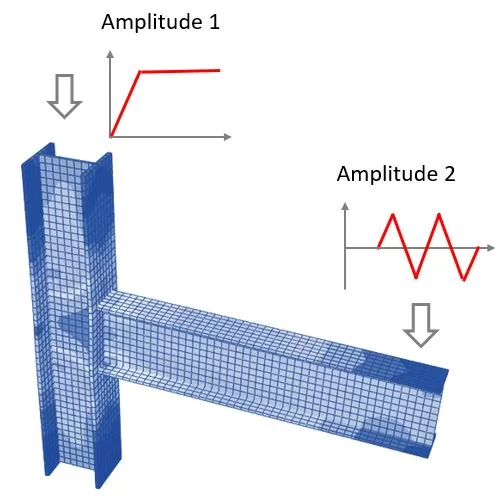分析タイプ
線形静的 – 静的解析, 弾性材料の特性を考慮します
線形座屈 – 選択した数の固有モードの線形安定性解析.
幾何学非線形静的 – 反復解析, 弾性材料の特性と形状の非線形性を考慮します (大きな変位)
ジオメトリ + 材料の非線形静的 – 反復静的解析では、材料と形状の非線形性が考慮されます。 (大きな変位)
ジオメトリ + 材料非線形動的 – 反復動的解析では、材料と形状の非線形性が考慮されます。 (大きな変位)

静的設定
グローバル負荷係数 – この係数は、解析のためにモデル内のすべての負荷値に乗算されます。
期間と時間増分 – 反復分析の設定. ほとんどの分析ケースに対するこれらの設定は適切に設定されており、デフォルトで使用できます。.
動的設定
期間と時間増分 – 反復分析の設定.
結果出力手順 – 分析中の結果記録用
ダンピング – レイリー減衰, 比例減衰とも呼ばれます, 要素全体に割り当てられた粘性減衰のバリエーションを表します. このアプローチでは、減衰マトリックスを構築します。, として示される , 質量マトリックスの線形融合による そして剛性マトリックス
負荷振幅
非線形有限要素解析では, 負荷時間関数は、時間の経過とともに負荷がどのように適用されるかを定義する重要な機能です。. このソフトウェアは、さまざまなインスタンスでさまざまな負荷強度を割り当てる機能を提供します。, これは、負荷が一定ではない現実の状況をシミュレートする場合に特に役立ちます.
この機能を強化するには, the software allows the definition of two amplitude options for the loads. These amplitude options enable users to specify a pattern or a sequence of load values that change over the course of the analysis.
The first amplitude option can define the initial ramp-up of the load, allowing for a gradual increase from zero to the maximum load value, reflecting a more realistic application of force or pressure on the structure. The second amplitude option can describe a subsequent phase, such as a holding pattern, cyclic loading, or a decrease to simulate the removal of the load.
If you only need to deal with a single load amplitude, where all applied loads follow the same function, use ‘Amplitude 1’ as an example. The program will ignore the second amplitude if it is not used.



